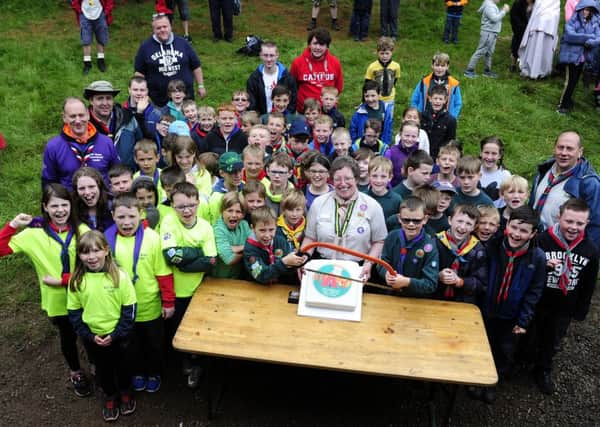Party plans to mark 100 year history


Scottish Cub Scouting has launched Cubs 100 involving Pack, Group, District, Regional and National events.
The 100 Big Birthday Bash at Fordell Firs at the start of the month was followed by the Family Open Day at Barrwood outside Denny last weekend when Beavers, Cubs, Scouts and Explorer Scouts from across Falkirk Scout District gathered for the official cutting of the specially baked Centenary birthday cake.
Advertisement
Hide AdAdvertisement
Hide AdCub Scouts have been set challenges around the theme of 100 to be tackled as an individual or a Pack before the end of a very special year.
They include: meeting someone who is 100 years old; writing a 100 word story; swimming 100 lengths as part of a group; earning 100 pennies; collecting 100 pieces of litter; finding out about a Cub Pack 100 miles away.
In December 1916, Wolf Cubs for eight to 11-year-olds was established by Robert Baden-Powell.
When they joined they were known as Tenderpads who had their eyes closed. Their challenge was to earn their stars, metal badges worn on their caps, to have both eyes open.
Advertisement
Hide AdAdvertisement
Hide AdTwo years earlier a pilot programme for younger boys, named ‘Junior Scouts’ or ‘Wolf Cubs’, had been launched and within a year membership had grown to 10,000.
In June 1916 the first Cubmasters conference was held and the following month Lady Scoutmaster Vera Barclay, who had established one of the first Cub packs, was appointed Assistant Secretary - Cubs.
In October that year ‘Wolf Cubs’ were given official standing by the Boy Scout Association and in November the Wolf Cub handbook, edited by Vera Barclay, and magazine were published.
At the official launch in Caxton Hall in London on December 16, 1916, Vera, who also devised the badge scheme, organised a ‘Grand Howl’ involving for 500 Wolf Cubs who also presented a display of gymnastics and ‘good turns’ in front of invited guests that included Baden-Powell who made a speech.
Advertisement
Hide AdAdvertisement
Hide AdExactly 100 years later, at 19.16 hours on December 16, 2016, over 150,000 Cub Scouts across the UK are expected to renew the Cub Scout Promise made that day to mark the official anniversary.
Today, just like then, the Cub programme boasts a huge variety of activities designed to help them stay fit, learn new skills, be creative, take part in adventurous activities including camping and get involved in their communities.
Since 1916, they have been learning how to tie knots, lay and light a fire outdoors, use matches safely and first aid including cleaning and dressing a cut finger and treating a small scald or burn.
Badge work challenged Wolf Cubs and now Cub Scouts to achieve.
Advertisement
Hide AdAdvertisement
Hide AdThere were 12 proficiency badges a Wolf Cub could earn - Collector, Observer, Gardener, Artist, Homecraft, Toy Maker, First Aider, Athlete, House Orderly, Team Player, Guide and Swimmer.
The top award for any Wolf Cub was the Leaping Wolf. Wolf Cubs had to have both 1st and 2nd Stars plus three proficiency badges (one had to be from the red set) to get their Leaping Wolf award.
It was hard work - but there was a lot of fun along the way and a great sense of satisfaction when you reached the end of the journey!
Winning a 1st Star was an awesome challenge in itself. Things to learn included how to fly the Union flag the right way up; the stories of St George, St Andrew and St Patrick; the first verse of the National Anthem and what to do when it is played; personal health, how to keep hands, feet, teeth and nails clean; be able to tell the time and know how pedestrians and cyclists should keep safe on the roads; clean a pair of shows and fold clothes neatly.
Advertisement
Hide AdAdvertisement
Hide AdFor the 2nd Star the tasks included knowing the eight points of the compass; how to tie a bowline, roundhitch and two half hitches; thrift, understanding the importance of saving money and looking after things; service, be able to memorise a message, run or cycle around a route and repeat the message correctly when you get back, use a public telephone and know how to get emergency assistance; safety, show the safe use of matches and know the dangers of broken glass, rusty nails and frayed flex. Know how to handle an electrical plug, light a gas ring or camping stove.
Wolf Cub Packs each had their own totem pole which consisted of a wooden staff about the length of a broom handle with a wolf’s head fixed on the top.
Every time a Wolf Cub was presented with a proficiency badge a ribbon was attached to the pole. The ribbon was the same colour as the badge, red, green, yellow or blue and the person’s name and that of the badge was written on the ribbon. At the end of the year a ring, bearing the date, could be slipped over the ribbons to divide those of one year from those gained in the next.
Other honours earned by the Pack were added, and Baden-Powell recommended new recruits ‘added’ their contributions to the Pack’s traditions by hammering a brass headed nail to the stem of the pole.